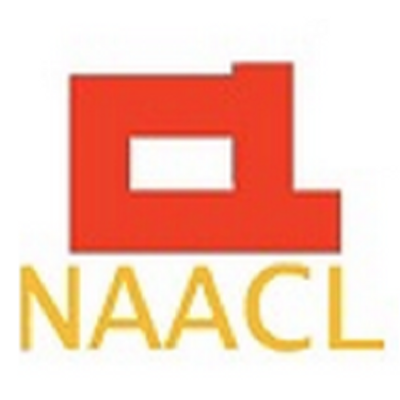naacl 2003 论文列表
Human Language Technology Conference of the North American Chapter of the Association for Computational Linguistics, HLT-NAACL 2003, Edmonton, Canada, May 27 - June 1, 2003.
|
Automatic Speaker and Language Recognition.
Optimization, Maxent Models, and Conditional Estimation without Magic.
NLP R&D and Commercial Deployment.
Annotation of Temporal and Event Expressions.
What's New in Statistical Machine Translation.
The State of the Art in Language Modeling.
Speech Recognition and Understanding.
Information Retrieval Systems as Integration Platforms for Language Technologies.
Introduction to Non-Statistical Natural Language Processing.
Identifying Opinionated Sentences.
Monolingual and Bilingual Concept Visualization from Corpora.
Speechalator: Two-Way Speech-to-Speech Translation in Your Hand.
Dynamic Integration of Distributed Semantic Services: Infrastructure for Process Queries and Question Answering.
pre-CODIE-Crosslingual On-Demand Information Extraction.
Automatic Extraction of Semantic Networks from Text using Leximancer.
Automatically Discovering Word Senses.
JAVELIN: A Flexible, Planner-Based Architecture for Question Answering.
WordFreak: An Open Tool for Linguistic Annotation.
Columbia's Newsblaster: New Features and Future Directions.
Demonstration of the CROSSMARC System.
QCS: A Tool for Querying, Clustering, and Summarizing Documents.
A Spoken Dialogue Interface to a Geologist's Field Assistant.
TAP-XL: An Automated Analyst's Assistant.
DOGHED: A Template-Based Generator for Multimodal Dialog Systems Targeting Heterogeneous Devices.
Alias-i Threat Trackers.
TIPS: A Translingual Information Processing System.
Cooperative model-based language understanding.
Spoken and Written News Story Segmentation Using Lexical Chains.
Investigations on Event Evolution on TDT.
Word Fragments Identification Using Acoustic-Prosodic Features in Conversational Speech.
A low-complexity, broad-coverage probabilistic Dependency Parser for English.
Indexing methods for efficient parsing.
Discriminating Among Word Senses Using McQuitty's Similarity Analysis.
Language choice models for microplanning and readability.
The Importance of Prosodic Factors in Phoneme Modeling with Applications to Speech Recognition.
Semantic Language Models for Topic Detection and Tracking.
Implicit Trajectory Modeling through Gaussian Transition Models for Speech Recognition.
Evaluating Answers to Definition Questions.
A Phrase-based Unigram Model for Statistical Machine Translation.
A Context-Sensitive Homograph Disambiguation in Thai Text-to-Speech Synthesis.
Building lexical semantic representations for Natural Language instructions.
Automatically Predicting Information Quality in News Documents.
Latent Semantic Analysis for Dialogue Act Classification.
Auditory-based Acoustic Distinctive Features and Spectral Cues for Robust Automatic Speech Recognition in Low-SNR Car Environments.
A Hybrid Approach to Content Analysis for Automatic Essay Grading.
Automatic Derivation of Surface Text Patterns for a Maximum Entropy Based Question Answering System.
LM Studies on Filled Pauses in Spontaneous Medical Dictation.
Bayesian Nets for Syntactic Categorization of Novel Words.
Desparately Seeking Cebuano.
Bootstrapping for Named Entity Tagging Using Concept-based Seeds.
References to Named Entities: a Corpus Study.
Category-based Pseudowords.
Semantic Extraction with Wide-Coverage Lexical Resources.
Precision and Recall of Machine Translation.
A Robust Retrieval Engine for Proximal and Structural Search.
Inferring Temporal Ordering of Events in News.
Towards Emotion Prediction in Spoken Tutoring Dialogues.
Word Alignment with Cohesion Constraint.
Cognates Can Improve Statistical Translation Models.
Unsupervised Learning of Morphology for English and Inuktitut.
dentifying and Tracking Entity Mentions in a Maximum Entropy Framework.
Automatic Expansion of Equivalent Sentence Set Based on Syntactic Substitution.
Detection Of Agreement vs. Disagreement In Meetings: Training With Unlabeled Data.
Rhetorical Parsing with Underspecification and Forests.
Question Classification with Support Vector Machines and Error Correcting Codes.
Target Word Detection and Semantic Role Chunking using Support Vector Machines.
A Maximum Entropy Approach to FrameNet Tagging.
Active Learning for Classifying Phone Sequences from Unsupervised Phonotactic Models.
Adaptation Using Out-of-Domain Corpus within EBMT.
Story Link Detection and New Event Detection are Asymmetric.
Exploiting Diversity for Answering Questions.
Getting More Mileage from Web Text Sources for Conversational Speech Language Modeling using Class-Dependent Mixtures.
Factored Language Models and Generalized Parallel Backoff.
Automating XML markup of text documents.
A Web-Trained Extraction Summarization System.
Unsupervised methods for developing taxonomies by combining syntactic and statistical information.
Toward a Task-based Gold Standard for Evaluation of NP Chunks and Technical Terms.
Evaluating the Evaluation: A Case Study Using the TREC 2002 Question Answering Track.
Feature-Rich Part-of-Speech Tagging with a Cyclic Dependency Network.
Frequency Estimates for Statistical Word Similarity Measures.
Example Selection for Bootstrapping Statistical Parsers.
Sentence Level Discourse Parsing using Syntactic and Lexical Information.
Comma Restoration Using Constituency Information.
Shallow Parsing with Conditional Random Fields.
Supervised and unsupervised PCFG adaptation to novel domains.
Statistical Sentence Condensation using Ambiguity Packing and Stochastic Disambiguation Methods for Lexical-Functional Grammar.
Language and Task Independent Text Categorization with Simple Language Models.
Syntax-based Alignment of Multiple Translations: Extracting Paraphrases and Generating New Sentences.
Weakly Supervised Natural Language Learning Without Redundant Views.
COGEX: A Logic Prover for Question Answering.
Multitext Grammars and Synchronous Parsers.
Automatic Evaluation of Summaries Using N-gram Co-occurrence Statistics.
A Weighted Finite State Transducer Implementation of the Alignment Template Model for Statistical Machine Translation.
A Generative Probabilistic OCR Model for NLP Applications.
Statistical Phrase-Based Translation.
A* Parsing: Fast Exact Viterbi Parse Selection.
Word Sense Acquisition from Bilingual Comparable Corpora.
Inducing History Representations for Broad Coverage Statistical Parsing.
A Categorial Variation Database for English.
Semantic Coherence Scoring Using an Ontology.
Learning Semantic Constraints for the Automatic Discovery of Part-Whole Relations.
Greedy Decoding for Statistical Machine Translation in Almost Linear Time.
Simpler and More General Minimization for Weighted Finite-State Automata.
Latent Semantic Information in Maximum Entropy Language Models for Conversational Speech Recognition.
An Analysis of Clarification Dialogue for Question Answering.
Minimally Supervised Induction of Grammatical Gender.
Automatic Acquisition of Names Using Speak and Spell Mode in Spoken Dialogue Systems.
In Question Answering, Two Heads Are Better Than One.
Learning to Paraphrase: An Unsupervised Approach Using Multiple-Sequence Alignment.
Japanese Named Entity Extraction with Redundant Morphological Analysis.
Effective Utterance Classification with Unsupervised Phonotactic Models.


